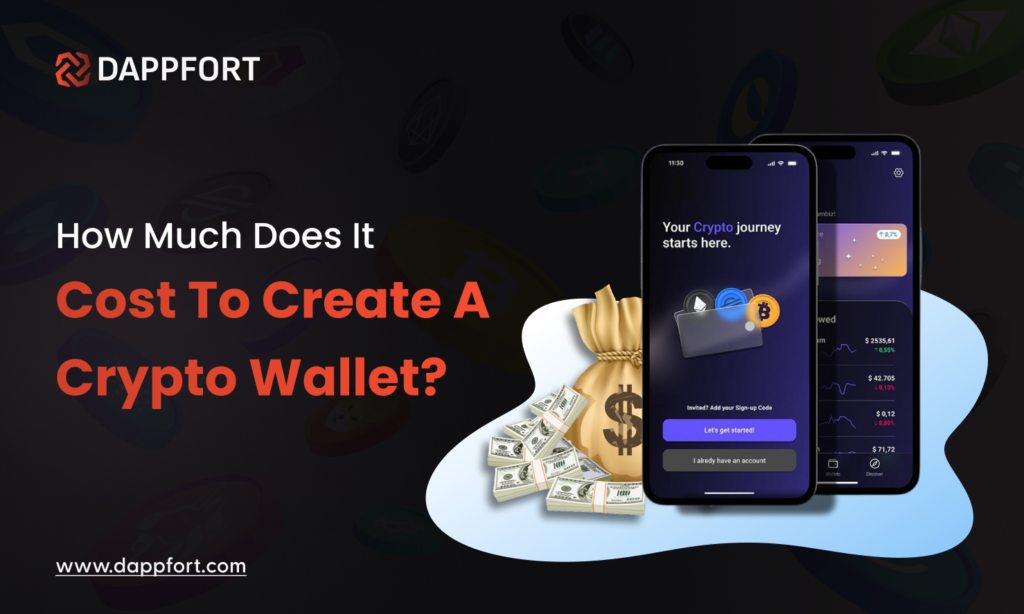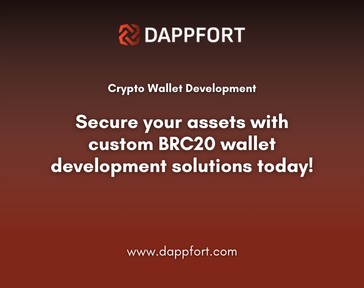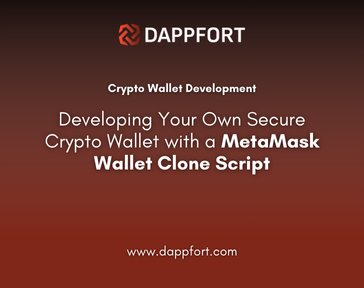
In the modern digital world, crypto wallets have become a mainstream requirement from a niche feature. With increasing numbers of people and businesses adopting digital currencies, the demand for secure, easy-to-use wallet solutions is higher than ever. Whether it’s holding tokens, engaging with dApps, or collecting NFTs, crypto wallets are the portal to Web3.
How much does it cost to develop a Crypto Wallet?
From core functionality and blockchain integrations to security protocols and compliance needs, a variety of factors influence the total cost of development. At Dappfort, we’ve worked with startups and enterprises for years to develop scalable, secure, and tailored crypto wallets. This blog breaks down all the major cost drivers so you can plan your wallet development project with confidence and clarity.
Factors Affecting the Cost of Developing a Crypto Wallet
Type of Crypto Wallet (Custodial vs. Non-Custodial)
One of the most significant cost-determining factors is what kind of wallet you wish to create: custodial or non-custodial. Custodial wallets transfer control of the private keys to a third party, usually involving server-side management, user databases, and sophisticated security layers. Non-custodial wallets enable users to have full ownership and control over their private keys. While non-custodial wallets minimize server infrastructure expense, they need to have impenetrable client-side security, sophisticated encryption schemes, and key recovery methods all of which can contribute to development time and cost.
Essential Features and Functionalities
The greater the number of features your crypto wallet supports, the more development resources and time needed. Simple wallets have basic features such as sending, receiving, and holding cryptocurrencies. Modern users, however, demand much more—multi-coin and multi-chain support, QR code scanning, in-real-time transaction history, biometric authentication, push notifications, and linking to DeFi protocols or NFT storage. Each of these aspects entails further backend logic, frontend UX design, and exhaustive testing, each of which influences the ultimate cost of development.
Security Measures and Compliance Costs
Security comes first when working with digital property, so it’s one of the most labor-intensive aspects of wallet creation. There needs to be high-level encryption, PIN/password protection, biometric authentication, seed phrase saving, and protection against phishing measures in place to secure user property. With custodial wallets, KYC/AML regulatory compliance and GDPR-compliant operations may also contribute to the cost, particularly if implementing third-party identity verification services or employing legal advisers for jurisdiction guidance.
Development Approach (Custom Development vs. White-Label Solutions)
The development method you opt for—white-label solution or custom development—has a significant contribution to the overall cost. Custom-built wallets provide full flexibility and branding options but entail longer development timeframes and larger budgets. A completely custom non-custodial wallet can take months of testing and development. Alternatively, white-label wallet solutions, such as those provided by Dappfort, provide pre-existing infrastructure along with essential wallet features so that businesses can deploy quicker and at a lower price point. These can even be customized in UI, chain support, and brand aspects without any trade-off in quality.
UI/UX Design Complexity and Customization
User experience is critical in the crypto universe, particularly for users who are not technically savvy. Intuitive and beautiful design not only improves usability but also inspires trust from users. Creating slim, mobile-friendly and desktop-friendly interfaces that react gracefully to blockchain activity adds depth to complexity. Custom animations, interactive elements, and multilingual support add to the development load, and consequently, the cost involved.
Third-Party Integrations (Blockchain APIs, KYC, and Payment Gateways)
The majority of wallets now depend on third-party service for blockchain information, price feeds, ID verification, or fiat on/off-ramp. Plugging these services in—either it’s a blockchain explorer API, a crypto price feed, or a KYC provider—takes development time and, in some instances, subscription fees on a recurring basis. Besides, to enable card buying of crypto or bank transfers, wallets require payment gateway integration, which typically involves setup fees as well as regulatory approvals.
Blockchain Network Selection and Scalability
Handling several blockchain networks like Bitcoin, Ethereum, Solana, Polygon, or BNB Chain is done through bespoke wallet logic per each. Each chain boasts a different structure, gas fee dynamics, and signing schemes, so the cost of development grows with each supported chain. In case your idea is to have a wallet work with Layer 2 solutions or sidechains, technical planning will be more extensive to support scalability and hassle-free user interaction.
Estimated Cost Breakdown for Crypto Wallet Development
Development Cost by Region (USA, Europe, Asia, etc.)
Development expenses will really depend on where your agency or team is based. In Western Europe or the U.S., having a feature-filled crypto wallet would cost somewhere between $100,000 and more in some cases depending on complexity and higher compliance requirements. However, blockchain development companies from Asia or India could offer similar solutions ranging between $25,000 and $80,000. At Dappfort, we offset this disparity by offering premium blockchain wallet development solutions at competitive prices on the international level.
In-House vs. Outsourced Development: Cost Comparison
Creating an in-house team to develop wallets entails long-term commitments such as hiring fees, infrastructure, equipment, and constant training. Outsourcing with a dedicated blockchain firm like Dappfort can significantly reduce initial costs while guaranteeing access to seasoned professionals who have developed such products previously.
This method also decreases the risk of a project to fail, accelerates delivery, and makes maintenance easy.
Hidden Costs in Crypto Wallet Development
In addition to upfront development costs, there are also hidden crypto wallet development costs that usually arise during or after the project. These can be app store listing charges, cloud hosting fees, periodic updates, bug fixes, smart contract audits, and customer support infrastructure. Moreover, marketing and user acquisition after the launch may demand its own budget. Budgeting for these upfront ensures your financial runway and facilitates seamless scaling.
How to Reduce the Cost to Create a Crypto Wallet?
Choosing the Right Development Approach
Cost optimization begins with selecting the development path that best suits your objectives. If your project timeline is short or you prefer to test market demand prior to full customization, white-label wallets are the best option. These enable quick deployment and concentrate on user acquisition without heavy investment in core technology development. If you are looking for a distinctive product with sophisticated DeFi or NFT capabilities, a phased custom development approach can allow you to amortize costs over time.
Leveraging White-Label Solutions for Cost Efficiency
White-label wallet products by Dappfort include all the necessary features already built, such as multi-chain support, security measures, and a user-friendly interface. The solutions not only save on cost but also get customized according to your brand. They significantly shorten go-to-market time and keep maintenance expenses stable. Through the white-label solution, companies are able to invest more time in user acquisition and partnerships rather than backend complications.
Partnering with Blockchain Development Companies
Collaborating with an experienced blockchain development company such as Dappfort keeps you from falling into the pitfalls and reduces time to market. Our developers possess more than five years of experience in blockchain SaaS development and have thorough expertise in wallet architecture, smart contract integration, and secure storage design. We offer clear pricing, flexible engagement models, and end-to-end technical support—from MVP to post-launch scaling.
Conclusion
Creating a crypto wallet comprises various works and mentioned above ranging from the wallet model and blockchain integrations to security, UI/UX, and compliance needs. Although the price may differ significantly based on your idea and implementation plan, having the appropriate collaborator at your side can be the turning point. At Dappfort, we merge creativity with affordability and provide top-notch crypto wallets designed to scale. If you’re ready to turn your wallet concept into reality, contact us today to receive a customized quote that fits your requirements.



